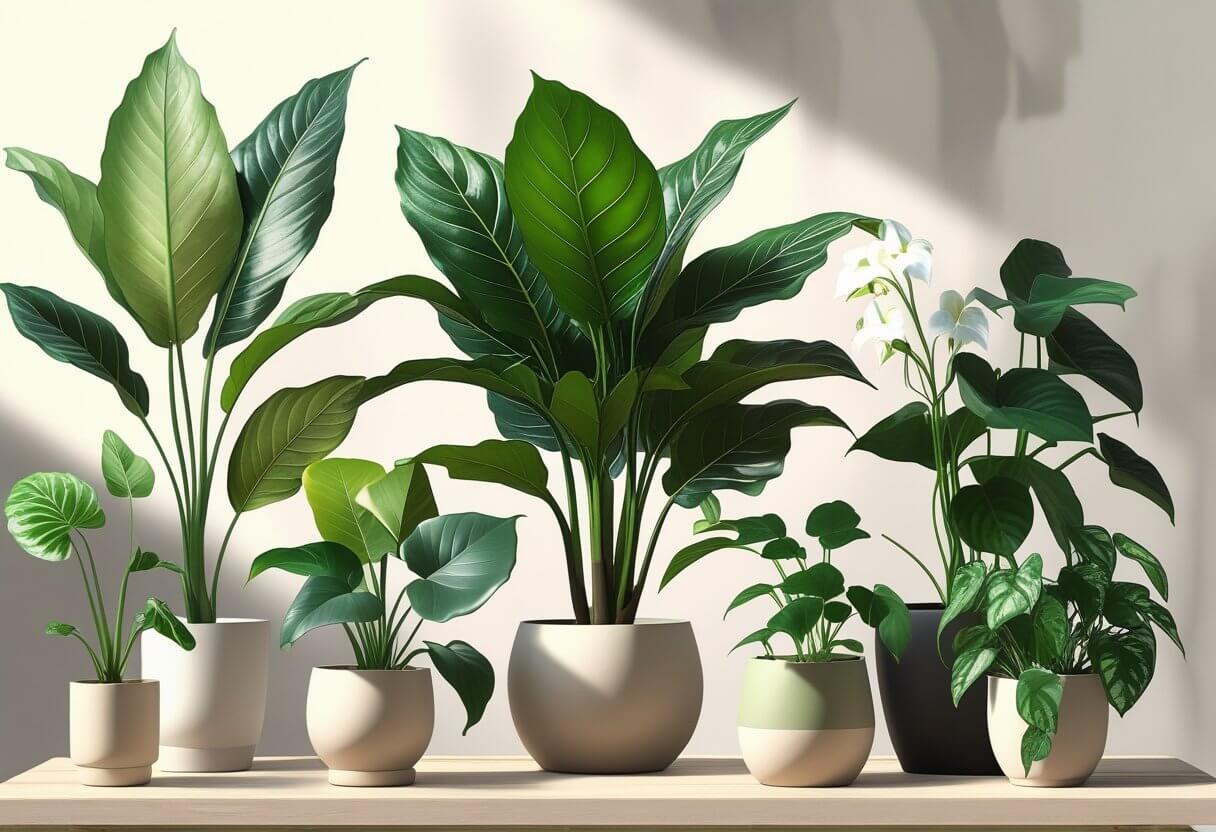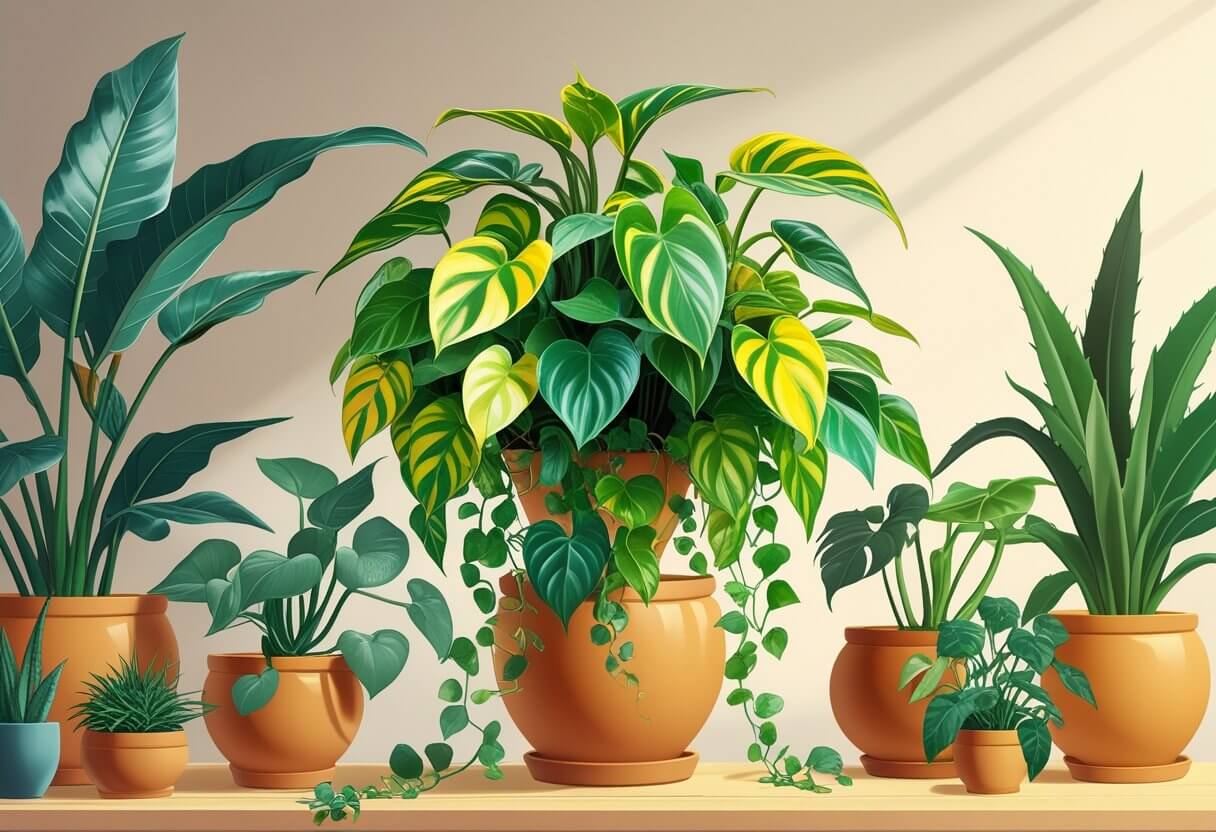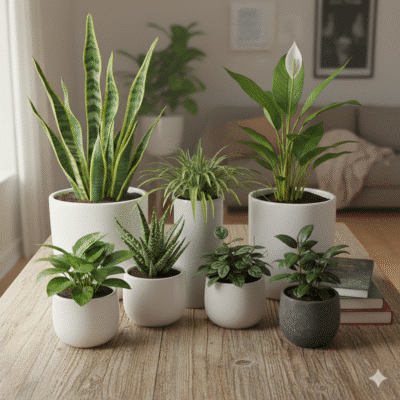Houseplants are everywhere these days, and it’s easy to see why. They add charm to any room and bring some health perks too. People want plants that actually fit their routines—maybe something that doesn’t sulk if you forget to water it, or one that thrives in that weird, shady corner.
The 7 best houseplants blend easy care, good looks, and a knack for cleaning the air. They’re solid picks for both newbies and folks who already have a jungle at home. The right plant can change a room’s vibe and boost your mood—without turning you into a full-time gardener.
1) Fiddle Leaf Fig

The fiddle leaf fig (Ficus lyrata) stands out with its big, shiny, violin-shaped leaves. It brings a bold, sculptural look to indoor spaces, and lots of people use it as a showpiece in living rooms or offices.
It likes bright, indirect light. Too much sun will scorch the leaves, but too little makes it sulk and drop leaves. You’ll want to water only when the top inch of soil feels dry.
This plant does best in well-draining soil and moderate humidity. If you let conditions swing too much, you might see brown spots or leaves dropping. To propagate, use stem cuttings—leaf cuttings won’t do the trick.
Compact types like the Bambino work well on desks or shelves. Fiddle leaf figs can be a bit fussy, but their dramatic look makes them worth the effort if you’re up for it.
2) Golden Pothos

Golden pothos is super popular, thanks to its heart-shaped leaves splashed with green and yellow. It’s adaptable and easy to care for, so beginners and long-time plant parents both love it.
The vines can trail from baskets or climb up a moss pole, and it doesn’t fuss much about lighting. It’ll handle low to moderate light, but brighter indirect light really brings out the colors.
Golden pothos helps clean the air, pulling out stuff like formaldehyde and benzene. It’s tough and versatile, so you can put it almost anywhere—kitchen, bathroom, you name it.
Just snip a stem to propagate and you’ll have more in no time. Honestly, it’s hard to beat golden pothos for looks, resilience, and how easy it is to keep alive.
3) ZZ Plant
The ZZ plant (Zamioculcas zamiifolia) is famous for being nearly impossible to kill. It shrugs off low light and only wants water when the soil has dried out almost completely. If you travel a lot or forget to water, this one’s for you.
Its glossy, deep green leaves look sleek and modern. Even in a dim room, it keeps going strong.
Besides looking good, the ZZ plant also helps clean the air by reducing toxins like xylene, toluene, and benzene.
You’ll find some varieties with different leaf shapes or shades, but honestly, they’re all equally easy to care for. It’s a reliable pick for anyone, whether you’ve got a green thumb or not.
4) Monstera Deliciosa
Monstera Deliciosa (the Swiss Cheese Plant) turns heads with its big, glossy leaves full of natural holes. It’s originally from Central America and climbs trees in the wild.
Indoors, it can get pretty huge—sometimes over 10 feet tall. It likes bright, indirect light for those dramatic leaf splits, but it won’t complain too much in lower light.
Let the top inch of soil dry before watering again. Use well-draining soil and feed it now and then during spring and summer.
It’s not a demanding plant, so it works for beginners or anyone wanting that tropical vibe. Monstera’s got a way of making any space look lush and lively.
5) Silver Leaf Philodendron
The Silver Leaf Philodendron (Philodendron hastatum or Silver Sword) is all about those silvery, arrow-shaped leaves. They almost look metallic—pretty cool if you ask me.
It’s easy to keep happy. Give it bright, indirect light for the best color, but it’ll tolerate a bit less (just expect the silver to fade some).
This plant climbs or trails, so you can put it on a shelf or let it climb a pole. It likes well-draining soil and moderate watering—let the soil dry out a bit before watering again or you’ll risk root rot.
If you want something a little different for your collection, this one’s a standout. Prune it now and then to keep it looking tidy and encourage new growth.
6) Prayer Plant
The Prayer Plant (Maranta leuconeura) gets its name from how its leaves fold up at night—kind of like hands in prayer. The patterns on the leaves are wild, with some having bright red veins or mosaic-like markings.
It likes conditions similar to its tropical roots: bright, indirect light and steady moisture. Too much sun will scorch it, so don’t stick it right in a window.
Humidity makes a big difference. If your place is dry, misting or a humidifier can help keep it happy.
Prayer plants stay low and spread out, making them great for shelves or tabletops. They’re not the easiest, but the payoff is worth it if you want something eye-catching.
7) Polka-Dot Begonia
The Polka-Dot Begonia (Begonia maculata) is hard to miss with its spotted leaves. The green leaves have pale silver or white dots, and the undersides are a striking burnt orange-red. Sometimes it even puts out delicate white or pinkish flowers.
It does best in bright, indirect light and likes its soil to be just slightly moist—not soggy. Well-draining soil and a bit of extra humidity will keep it looking its best.
It’s not too tricky to grow, so both beginners and seasoned collectors can enjoy it. If you want a plant that brings a little drama and color, this one’s a winner.
Care Guide for Popular Houseplants
Getting houseplants to thrive isn’t rocket science, but you do need to know what they want—how much light, when to water, and how to spot trouble before it gets out of hand. A bit of consistency goes a long way.
Lighting Requirements Explained
Different plants have different light needs. Most of the favorites want bright, indirect light—so, near a window but not baking in the sun. Snake plants and ZZ plants will tolerate low light, but don’t expect them to grow fast.
Direct sun can fry delicate leaves, so skip the harsh afternoon rays for sensitive types. If your place is dark, try a grow light—plants aren’t picky about where the light comes from as long as they get enough.
If you notice leaves fading or stretching out, your plant’s probably asking for a new spot. Sometimes it takes a bit of trial and error to get it right.
Watering Best Practices
Honestly, most plant problems come from too much water. Let the soil dry out a bit before watering again—stick your finger in about an inch deep to check. It’s simple, but it works.
Give enough water so it drains out the bottom, but don’t let the pot sit in water. Each plant has its own preferences—ferns want more moisture, succulents want less.
Humidity changes how often you’ll need to water. In winter, you’ll probably need to water less, but misting or a humidifier helps plants that like it humid.
Common Mistakes to Avoid
Inconsistent watering—either too much or too little—stresses plants and causes leaf drop or root trouble. Pots without drainage holes are a recipe for disaster.
The wrong soil can mess things up. Succulents need fast-draining soil, while tropical plants prefer something richer. Overdoing fertilizer can burn roots, so go easy.
Don’t ignore pests or skip adjusting your care as seasons change. Check leaves now and then, and repot when roots fill the pot. Little things like this keep plants happy.
Benefits of Indoor Plants
Indoor plants do more than just look good—they actually help the space and the people in it. They freshen up the air and can even lift your mood on a rough day.
Air Quality Improvement
Plants filter out toxins and boost oxygen. Some, like the snake plant and peace lily, pull pollutants like formaldehyde, benzene, and carbon monoxide right out of the air. It’s a natural way to cut down on indoor pollution.
They also add humidity, which can help with dry skin or allergies—especially in winter when heaters dry everything out.
Some top air-purifying plants:
- Snake plant
- Spider plant
- Peace lily
By raising oxygen and humidity, plants make indoor air feel fresher—especially if you’re in a sealed-up or dry space. Sometimes it’s the little things that make a big difference.
Stress Reduction Insights
Caring for indoor plants often helps people feel less stressed and boosts their mood. Some studies even suggest that just being around plants can drop stress hormone levels by about 20%—pretty impressive for something so simple.
The routine of watering, pruning, and just watching plants grow nudges you into a mindful state. That quiet focus offers a real break from the usual daily chaos and helps keep your mind in check.
Greenery around you tends to help you relax and might even sharpen your focus or lift your productivity. Even a few minutes spent near plants can leave you feeling noticeably calmer.
Honestly, plants make for some of the lowest-effort, highest-reward tools for mental well-being, whether you’re at home or stuck at your desk.



